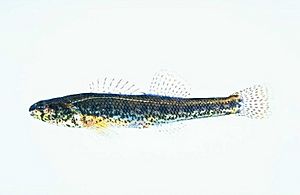Swamp darter facts for kids
Quick facts for kids Swamp darter |
|
|---|---|
 |
|
| Conservation status | |
| Scientific classification | |
| Synonyms | |
|
The swamp darter (Etheostoma fusiforme) is a small, freshwater ray-finned fish. It is a type of darter, which belongs to the same family as perches. This fish lives only in the Eastern United States.
Contents
What Does It Look Like?
This fish can grow up to about 5.9 centimeters (2.3 inches) long, but most are around 4 centimeters (1.6 inches). It has a slim body and a rounded head. Its snout is blunt and doesn't stick out past its upper lips.
Swamp darters are usually green or tan on top. They have small dark spots and green-brown patterns. Their sides have 10 to 12 square-shaped marks. Their undersides are white or yellow with many black and brown speckles. They also have a dark bar under their eyes and three dark spots on their tail fin.
The rays in their fins have small spots. Male swamp darters have a dark band at the base of their spiny dorsal fin (the fin on their back). They also have another dark band near the edge of this fin. When it's time to breed, males become darker. They also grow small bumps called tubercles on their pelvic and anal fins.
Where Do Swamp Darters Live?
Swamp darters are found in many low-lying areas of the eastern United States. They live along the Atlantic and Gulf coasts, from southern Maine all the way to the Sabine River in Louisiana. You can also find them in parts of Oklahoma and in rivers that flow into the Mississippi River, as far north as Kentucky and Missouri.
There's even a group of swamp darters that were introduced to the French Broad River system in North Carolina. In New York State, they are only found in the Peconic River and a few nearby ponds on Long Island. No other darter fish lives as far south as the swamp darter.
Habitat and Life Cycle
Where They Live
Swamp darters like slow-moving or still waters. This includes ditches and oxbow lakes, which are common in low coastal areas. They prefer clearer water with more plants. They can live in flowing water but usually choose still places like ponds or areas behind beaver dams. They often live in dark, acidic waters but can also do well in clear water if there are enough places to hide.
What They Eat
Swamp darters eat small water creatures. Their diet includes fly larvae, amphipods, and other small crustaceans and insects. Young chain pickerel and young largemouth bass often eat swamp darters, especially where these fish live together.
Reproduction
Swamp darters usually breed in spring, from March to May. They are not shy about spawning (laying eggs). They typically breed in the same places where they live.
During breeding, the male approaches the female from behind. He then climbs on her back and gently taps her with his pelvic fins. The female then leads him into water plants. There, she lays her eggs one by one on the leaves. The parents do not take care of the eggs after they are laid.
Swamp darters usually live for only about one year. Very few of them survive for two years.
Conservation Status
The swamp darter has faced some local problems. Human activities like building cities, farming, and draining wetlands have changed their homes. Pollution and dirt in the water have also reduced the places they can live. Because of this, they are rare in some areas, like Missouri, where they are listed as endangered.
However, overall, the swamp darter has a very wide range and a large population. There are many groups of them, and their numbers are generally stable. Because of this, the IUCN (a group that studies wildlife) says the swamp darter is of "Least Concern". This means they are not currently at high risk of disappearing.
About Their Name
The swamp darter was first officially described in 1854 by a French biologist named Charles Frédéric Girard. He named it Boleosoma fusiforme. The name fusiforme means "spindle shaped" or "tapering at each end," which describes the fish's body shape.
There are two main types (subspecies) of swamp darter:
- E.f. barretti: Found from the Pee Dee River in South Carolina and in the southern and western parts of its range.
- E.f. fusiforme: Found along the northern Atlantic coast, from the Waccamaw River in North Carolina up to Maine.
See also
 In Spanish: Etheostoma fusiforme para niños
In Spanish: Etheostoma fusiforme para niños


